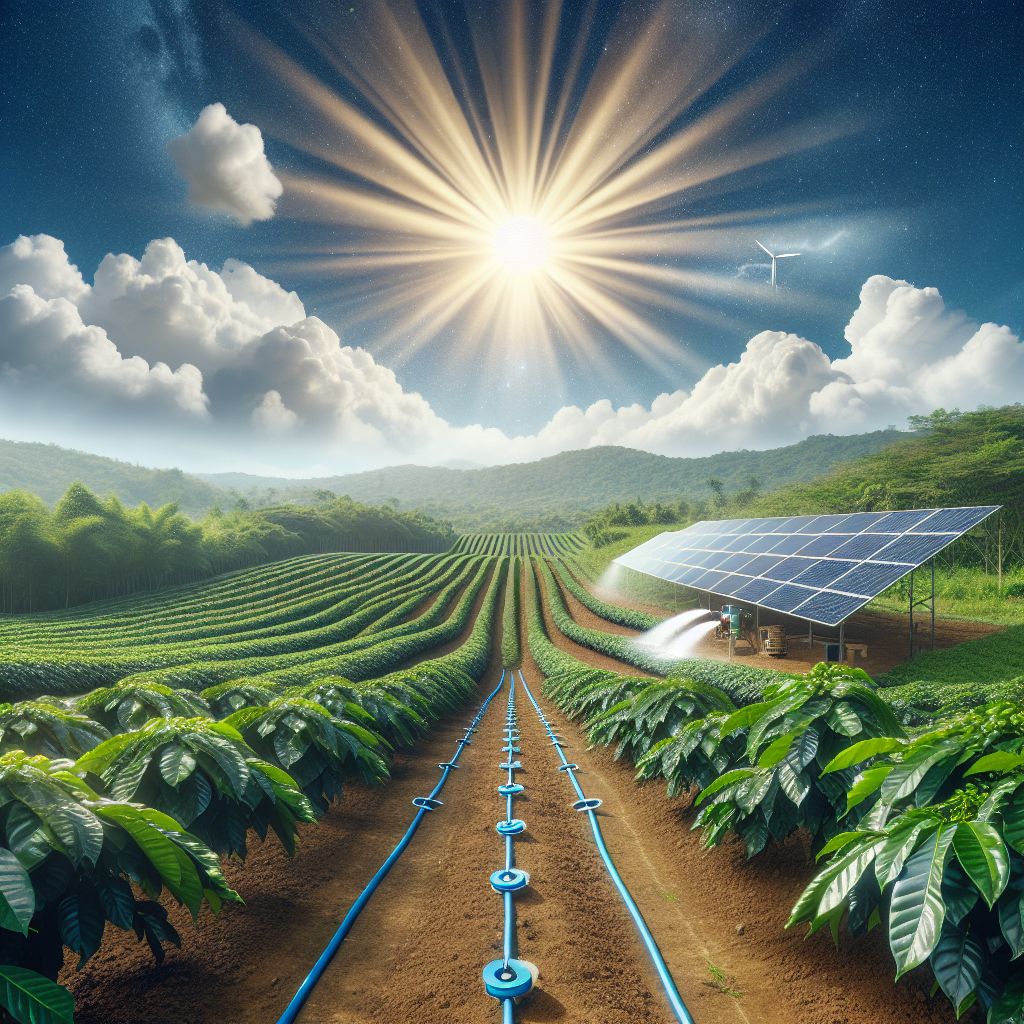
When it comes to cultivating coffee, every single drop of water is precious. You want your beans to flourish, but you also want to conserve resources and keep your farm as eco-friendly as possible. That’s where solar irrigation systems come in. They’re a game-changer for both your crops and the environment.
Main Points
Solar irrigation systems are an environmentally-friendly way to hydrate coffee plants while saving energy.
Drip irrigation is the most effective way to conserve water, delivering it directly to the roots of the plant.
By incorporating solar power, you can significantly cut down on energy costs and dependence on non-renewable resources.
Adjusting irrigation schedules to meet the needs of the coffee plant results in improved yields and better resource management.
Regular upkeep of solar irrigation systems ensures they remain efficient and last a long time.
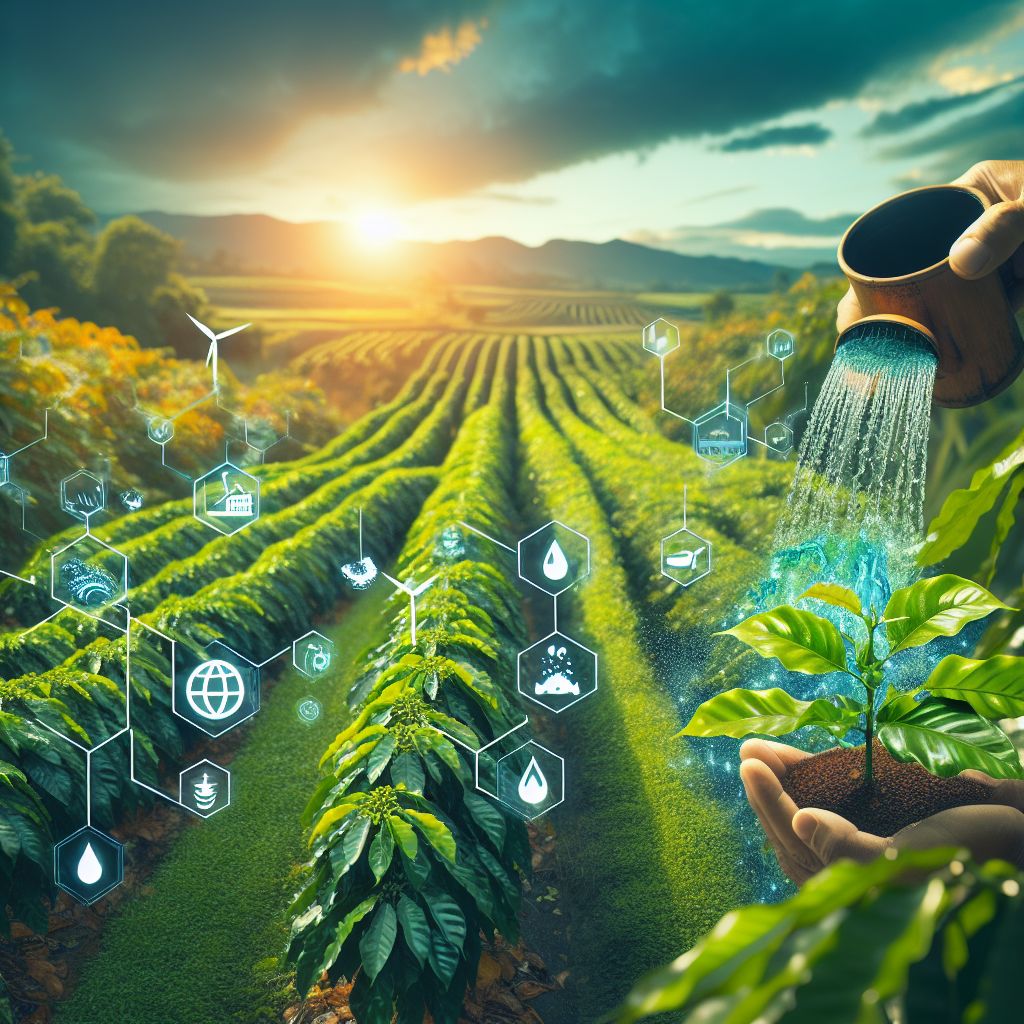
Why Effective Irrigation is Important for Your Coffee Crop
Let’s start at the beginning. Your coffee plants need water to grow, but not just any watering will suffice. You need to be strategic about it because effective irrigation isn’t just about conserving water; it’s about making sure each drop goes exactly where it’s needed most.
How Water Affects Coffee Plant Development
Water is like a lifeblood for coffee plants. It carries nutrients from the soil to the plant, aids in photosynthesis, and even influences the final flavor of your coffee. But an excess or deficiency can lead to catastrophe. That’s why watering precision is so important. You want to make sure your plants receive just the right quantity at the right moment.
Results of Poor Watering Techniques
Wasting water doesn’t just hurt the environment; it’s also bad for the longevity of your farm. Poor watering practices can result in excessive resource use, increased costs, and potential harm to your valuable coffee plants. It’s all about striking the right balance.
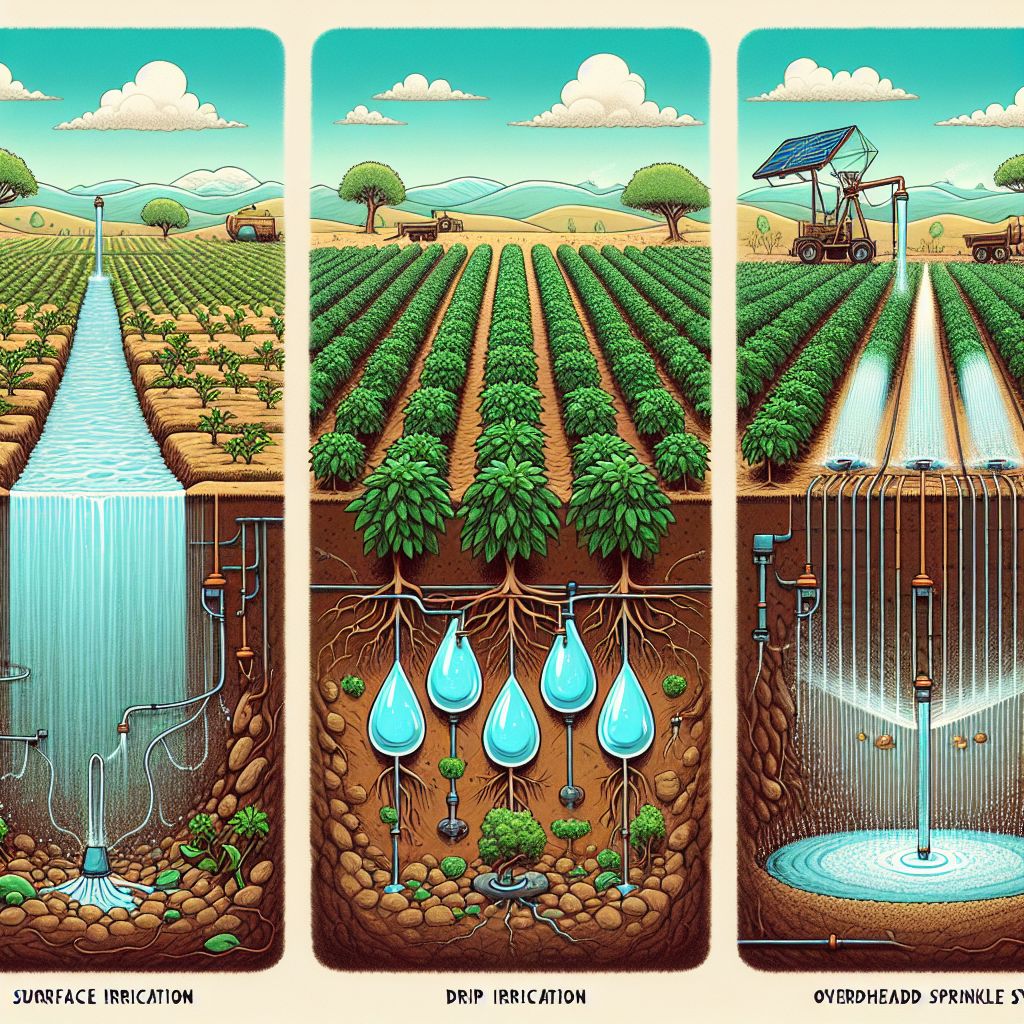
What Irrigation System is Right for You?
Deciding on an irrigation system can seem overwhelming, but it doesn’t have to be. Let’s take a look at the choices.
Traditional Surface Irrigation Methods
Surface irrigation is the tried and true method of watering crops. Water is allowed to flow over the soil surface by the force of gravity. It’s a straightforward approach that doesn’t require a lot of equipment, but it’s not always the most effective. It can lead to uneven watering, or even worse, water runoff that carries away valuable soil nutrients.
Drip Irrigation: An In-Depth Examination
Drip irrigation is akin to providing your coffee plants with their own individual water source. It supplies water directly to the roots, one drop at a time. This system is a significant water conservation tool and can decrease water usage by up to 50% in comparison to conventional methods. And since the water is delivered exactly where it’s required, your plants receive the ideal amount of hydration each time.
The Effects of Overhead Sprinkler Systems
Overhead sprinklers can be a decent compromise. They’re more effective than surface irrigation and can cover a lot of ground. However, they can also waste water due to evaporation and wind drift. It’s best to use them judiciously to prevent these issues. For more efficient watering solutions, consider exploring solar irrigation systems which can be a more sustainable option.
Here is a table showing the pros and cons of traditional surface irrigation, drip irrigation, and sprinkler irrigation systems for growing coffee:
|
Irrigation System |
Pros |
Cons |
|---|---|---|
|
Traditional Surface Irrigation |
– Low installation and equipment costs. 4 |
– High water usage and potential for water loss through evaporation, runoff, and deep percolation. 4 |
|
– Suitable for flat terrain. 4 |
– Uneven water distribution, leading to over/under-watered areas. 4 | |
|
– Labor intensive for land leveling and water channeling. 4 | ||
|
– Increased risk of soil erosion and nutrient leaching. 4 | ||
|
Drip Irrigation |
– High water use efficiency by delivering water directly to roots. 1, 2, 4 |
– Higher installation costs for piping and emitter systems. 4 |
|
– Emitters may need periodic replacement due to degradation. 3 | ||
|
– Suitable for all terrains and soil types. 4 |
– Soil moisture monitoring required to prevent under/over-watering. 4 | |
|
– Ability to operate at low pressure and flow rates. 4 |
– Unsuitable for germination and crop establishment stages. 4 | |
|
Sprinkler Irrigation |
– Relatively lower installation costs than drip. 4 |
– Higher water usage compared to drip due to evaporation and wind drift. 4 |
|
– Suitable for various terrains and soil types. 4 |
– Potential for uneven water distribution based on sprinkler spacing. 4 | |
|
– Can be used for crop establishment and all growth stages. 4 |
– Increased risk of foliar diseases from leaf wetness. 2 | |
|
– Ability to cool plants and reduce heat stress. 4 |
– Higher energy costs for operating pumps. 4 |

Making the Irrigation System Even More Efficient with Solar Panels
For coffee growers, efficient water management is crucial, and solar irrigation systems can offer a sustainable solution. These systems harness the power of the sun to provide a consistent water supply, ensuring that coffee plants receive the right amount of water without wastage. To understand how these systems can be optimized for coffee cultivation, consider exploring the benefits and best practices of solar irrigation systems for growing coffee.
Next, we’ll delve into the core of your solar irrigation system: the solar panels. These aren’t just any panels, they must be sturdy, effective, and above all, tailored to your coffee farm’s unique needs.
How to Select the Best Solar Panels for Your Needs
When choosing solar panels, you should take into account considerations such as weather, the angle of the sun, and the energy needs of your irrigation system. Choose panels with a high energy conversion rate to make sure you’re getting the most value for your money. You should also consider durability, as these panels will be exposed to the elements daily.
Financial Implications of Solar-Powered Irrigation
Let’s get down to brass tacks. The initial investment in a solar irrigation system might seem steep, but you need to factor in the long-term savings. With the sun as your power source, you can expect your energy bills to take a nosedive. Over time, those savings can not only recoup the cost of the system, but also put you in the black.
Here is a table comparing the pros and cons of having a solar irrigation system versus a regular irrigation system for growing coffee:
|
Pros of Solar Irrigation |
Cons of Solar Irrigation |
Pros of Regular Irrigation |
Cons of Regular Irrigation |
|---|---|---|---|
|
Environmentally sustainable, using renewable solar energy. 1, 4 |
Higher initial cost to install solar panels and equipment. 1, 4 |
Relies on electricity from non-renewable sources like fossil fuels. 1 | |
|
Lower operating costs since solar energy is free after installation. 1, 4 |
Efficiency can be reduced on cloudy days or during periods of low sunlight. 1, 4 |
Consistent water supply as long as electricity is available. 4 | |
|
Solar panels may take up land area that could otherwise be used for crop production. 1 |
No land area used by equipment besides pipes/sprinklers |
Contributes to greenhouse gas emissions and environmental pollution. 1 | |
|
Requires batteries or backup systems for energy storage to operate at night. 1, 4 |
Can operate continuously as long as grid electricity is available |
Relies on centralized electricity infrastructure that can be disrupted. 1, 4 | |
|
Solar panels have a limited lifespan and will eventually need replacement. 1, 4 |
Pumps and equipment may require more frequent maintenance |
Susceptible to fuel price fluctuations if using diesel/gas pumps. 3 | |
|
Potential to sell excess energy back to utility companies. 1 |
Intermittent water supply if solar energy production is insufficient. 1, 4 |
– |
– |
|
More efficient water usage by delivering water directly to roots. 2 |
Aboveground tubing can be degraded by sunlight and damaged. 2 |
Can use various irrigation methods like sprinklers or flooding |
Some methods like sprinklers can lead to water loss through evaporation. 2 |

Maximizing Irrigation Timing for Coffee Crops
Just like how you water your coffee plants, when you water them is equally important. You should aim to water your plants when they can most effectively use the water, typically in the cool early morning or evening. This minimizes evaporation and makes sure the water goes exactly where it should. For more insights on efficient watering solutions, explore our guide on solar irrigation systems for small farms.
For the best watering results, it’s crucial to know your plants. Coffee plants require varying amounts of water at different growth stages. During the flowering stage, they need extra water to help the flowers transform into beans. However, overwatering during the bean maturing stage could lead to splitting.
It may take some time and experimentation, but once you’ve found the right watering schedule, both your plants and your taste buds will be grateful.
Regularly check soil moisture levels and adjust irrigation accordingly.
Stay informed about upcoming weather to avoid watering before rain.
Change watering schedules based on the coffee plant’s growth stage.
Understanding the Water Needs of Coffee Plants
Coffee plants are quite particular about their water. They prefer their soil to be moist but not waterlogged. Overwatering can lead to root rot, which can destroy your crop. On the other hand, if they don’t get enough water, they can’t produce the full, flavorful beans we all love.
So, how do you find the right balance? It’s all about monitoring the soil. You want it to feel like a squeezed sponge—moist, but not sopping wet. And keep in mind, coffee plants have shallow roots, so they require a soft touch when it comes to irrigation.
Using Technology to Water with Precision
Technology can be a great friend when it comes to managing your irrigation. Soil moisture sensors, for instance, remove the uncertainty of when to water. They can tell you precisely how much moisture is in the soil, so you can water only when necessary. And with a solar-powered system, you can operate these devices without an additional impact on your power bill.
Implementing automated irrigation systems can be a game-changer. They can be programmed to water at the optimal time every single day, without exception. This not only frees up your time but also contributes to a more sustainable farming operation.
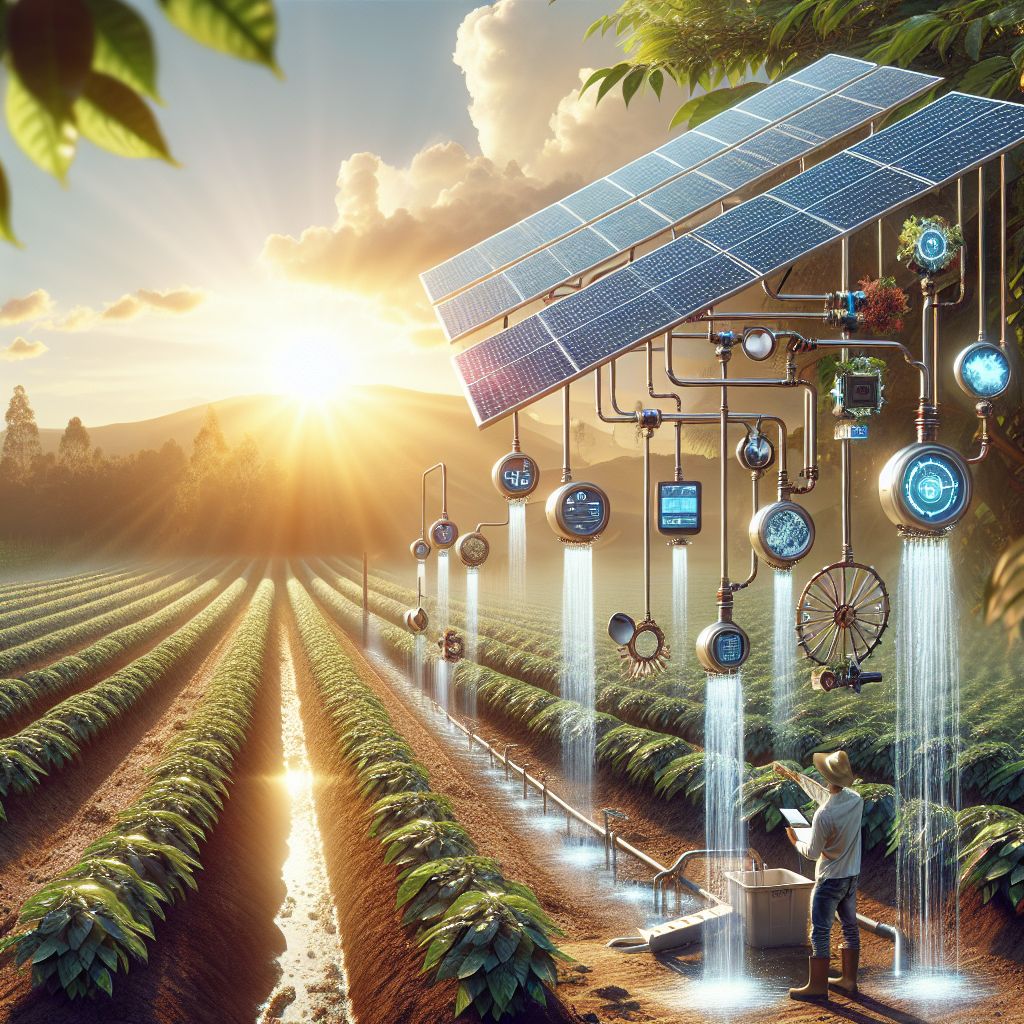
Keeping an Eye on Things: Making Your System Last
Like any big investment, a solar irrigation system requires regular attention and care. Just as you tend to your coffee plants, you need to tend to your irrigation system.
Maintenance and Problem Solving
It’s important to regularly inspect your system. Look for any leaks, ensure the solar panels are clear of debris, and check that all the connections are secure. If you find a problem, don’t delay in fixing it. The quicker you resolve any issues, the less harm they can cause.
Remember, your solar panels need a clear view of the sky to perform optimally. So, ensure they are clean and clear of leaves, dust, or anything else that might block the sunlight.
Improving Your System for Enhanced Results
As your farm expands and technology progresses, you may discover that your irrigation system requires an update. Perhaps you’ll incorporate additional sensors or transition to a more efficient solar panel model. Regardless, keeping up with the newest tech can assist in keeping your farm at the cutting edge of sustainability.
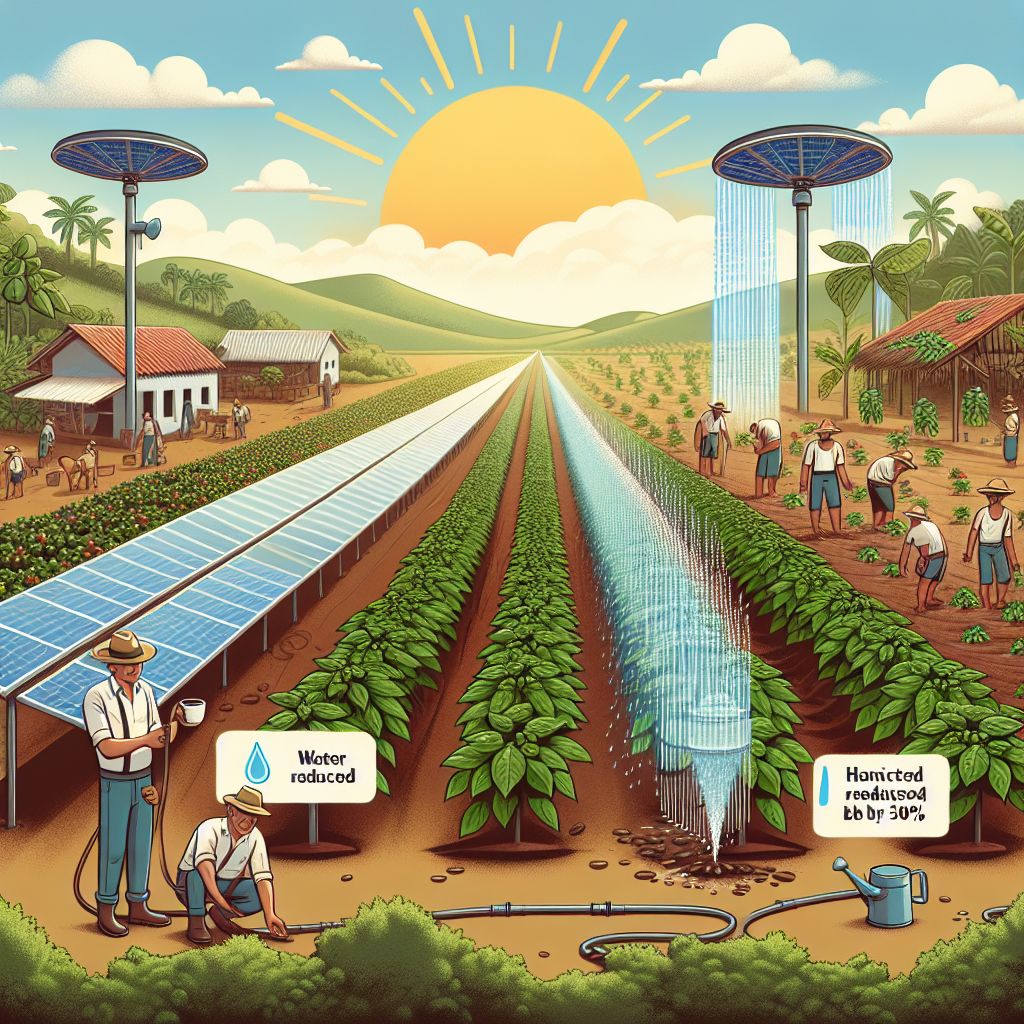
Success Stories: The Impact of Enhanced Irrigation
Let’s take a moment to discuss the transformative power of a solar irrigation system. There are coffee farms that have witnessed remarkable improvements after adopting this technology. Here are a few case studies.
Examples of Improved Harvests
A farm in Brazil once grappled with unpredictable rain and soaring energy prices. But after they converted to a solar-powered drip irrigation system, they managed to slash their water consumption by 50% and boost their harvest by 30%. This is a victory for both the planet and their profits.
Feedback from Coffee Farmers
But it’s not just about the stats. Farmers who’ve made the transition frequently mention the serenity it brings. A farmer from Colombia remarked, “The knowledge that I’m employing the sun to hydrate my crops gives me the impression that I’m providing them with the most genuine form of life. And I can perceive that authenticity in each bean.”
These tales are just the tip of the iceberg. With a solar irrigation system, you’re not just cultivating coffee; you’re fostering a portion of the future—a farm that is sustainable, efficient, and prosperous, giving back to the planet as much as it receives. And that’s something we can all be proud of.
Final Thoughts: Should Coffee Growers Invest in Solar Irrigation Systems?
Is a solar irrigation system the right choice for your coffee plantation? Without a doubt. The upfront cost may seem intimidating, but the long-term advantages are hard to ignore. Between the substantial savings on water and energy, lower expenses, and the positive effect on the environment, solar irrigation systems are a wise decision for any environmentally aware farmer. They’re not just beneficial for your plantation; they’re beneficial for the future of coffee cultivation.
Common Questions
Which irrigation method for coffee uses the least water?
Drip irrigation is the most water-conserving method for watering coffee plants. It delivers water right to the roots of the plant, which reduces waste and helps the plant absorb the most water possible.
How regularly do I need to water my coffee crops?
Many factors influence how often you should water your coffee crops, such as the maturity of the plants, the type of soil, the climate, and the weather. As a rule of thumb, coffee plants should be watered every 7 to 10 days during dry spells. However, it’s always best to keep an eye on soil dampness and adjust as needed. For more detailed guidance, consider exploring efficient watering solutions tailored for specific crops.
Is it cost-effective to use a solar panel system for irrigation?
Indeed, using a solar panel system for irrigation can greatly cut down costs. Although the initial cost can be steep, the savings from energy bills and the potential increase in yield from regular and efficient watering can more than compensate for the initial investment over time.
How can you keep track of a solar irrigation system’s effectiveness?
The most effective method for keeping track of a solar irrigation system’s effectiveness is by conducting regular checks and using monitoring technology like flow meters and soil moisture sensors. These tools can provide up-to-the-minute data on system effectiveness and notify you of any problems that need to be resolved.
How often should I perform maintenance on a solar irrigation system to keep it running smoothly?
While the frequency of maintenance for a solar irrigation system can differ, it is typically advised to conduct checks at least once a month. This includes cleaning solar panels, looking for leaks in the irrigation system, and confirming that all parts are working properly. Routine maintenance is key to extending the system’s lifespan and efficiency.







Leave a Reply